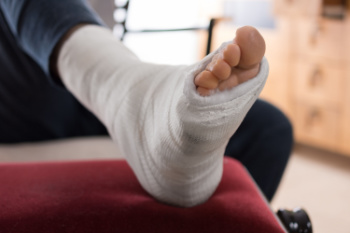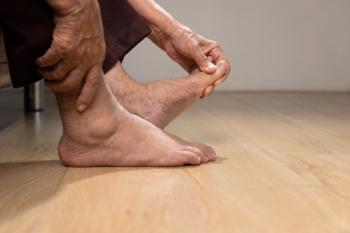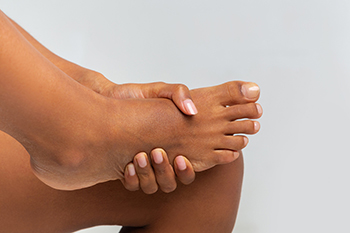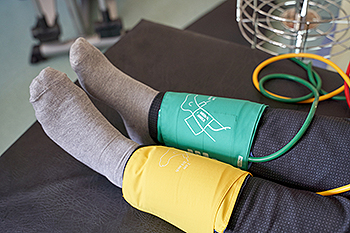Blog
Healing Times for a Broken Foot

Patience and proper care are key to a full recovery from a broken foot. Healing times can vary depending on the location and severity of the break, as well as the patient's overall health and age. Typically, bones take several weeks to mend, with the initial phase focusing on immobilization to ensure proper alignment. During this time, it is important to avoid putting weight on the injured foot to prevent complications. As the weeks progress, gradual weight-bearing activities may be introduced, guided by a podiatrist. Throughout the healing process, specific stretches and other exercises can play an essential role in restoring strength and flexibility. A consistent and careful approach will support the natural healing process, leading to a stronger and healthier foot. If you have broken your foot, it is suggested that you promptly visit a podiatrist who can guide you toward the correct treatment, which may include a walking boot or a cast.
A broken foot requires immediate medical attention and treatment. If you need your feet checked, contact Dr. Kevin Davis from Davis Foot & Ankle Centers. Our doctor can provide the care you need to keep you pain-free and on your feet.
Broken Foot Causes, Symptoms, and Treatment
A broken foot is caused by one of the bones in the foot typically breaking when bended, crushed, or stretched beyond its natural capabilities. Usually the location of the fracture indicates how the break occurred, whether it was through an object, fall, or any other type of injury.
Common Symptoms of Broken Feet:
- Bruising
- Pain
- Redness
- Swelling
- Blue in color
- Numbness
- Cold
- Misshapen
- Cuts
- Deformities
Those that suspect they have a broken foot shoot seek urgent medical attention where a medical professional could diagnose the severity.
Treatment for broken bones varies depending on the cause, severity and location. Some will require the use of splints, casts or crutches while others could even involve surgery to repair the broken bones. Personal care includes the use of ice and keeping the foot stabilized and elevated.
If you have any questions please feel free to contact our office located in Springfield, TN . We offer the newest diagnostic and treatment technologies for all your foot and ankle needs.
Wearing the Right Shoes While Landscaping

Wearing the right shoes while landscaping is essential for both safety and comfort. Proper footwear provides the necessary support and protection for your feet during strenuous outdoor activities. Landscaping often involves uneven terrain, sharp tools, and heavy lifting, making sturdy shoes with good traction vital to prevent slips and falls. Shoes with reinforced toes and durable materials protect against injuries from tools or debris. Additionally, supportive shoes help reduce fatigue and prevent foot and ankle strain, enabling you to work longer and more efficiently. Good arch support and cushioning also contribute to overall foot health, reducing the risk of chronic conditions like plantar fasciitis. Investing in high-quality, appropriate footwear ensures that you can tackle landscaping tasks safely and comfortably. If you have injured your foot from wearing the wrong shoes while landscaping, it is suggested that you speak to a podiatrist who can treat the condition and discuss what type of shoes are needed while landscaping.
While working on the feet, it is important to take the proper care of them. For more information about working on your feet, contact Dr. Kevin Davis from Davis Foot & Ankle Centers. Our doctor will treat your foot and ankle needs.
Working on Your Feet
Standing on your feet for long periods of time can cause stress and pain in your feet. Your whole body may experience change in terms of posture, back pain, bunions, callouses and or plantar warts. There are ways to avoid these conditions with proper foot care, smart choices and correct posture.
Positive Changes
Negative heeled shoe – Choosing this shoe type places the heel slightly lower than the ball of the foot. These are great for overall foot health. Find shoes that fit you correctly.
Go barefoot – Our feet were not designed to be enclosed for all hours of the day. Try to periodically expose your feet to air.
Eliminate Pain
Foot Exercises – Performing simple exercises, incorporating yoga and doing stretches are beneficial. This will allow increased blood flow to the area and muscles of the foot.
Achilles tendon – Stretching the foot out flat on the floor will relax the calf muscles and tendon. These exercises can be performed almost anywhere. Make sure you add these exercises to your daily regimen.
With a little bit of this information and knowing more about foot health, you will notice changes. Foot stretches and proper footwear will help with pain and prevent further issues.
If you have any questions please feel free to contact our office located in Springfield, TN . We offer the newest diagnostic and treatment technologies for all your foot and ankle needs.
Facts About Bunion Surgery

A bunion, medically termed hallux valgus, is a bony protrusion on the inner side of the foot, precisely at the base of the big toe. This condition arises from the misalignment of the bones in the forefoot, compelling the big toe to angle towards the lesser toes, consequently protruding the joint at its base. Bunions can cause significant discomfort and interfere with your daily activities. If you have exhausted nonsurgical options like padding or orthotic shoes, bunion surgery may be the next step to relieve your pain and improve mobility. During the procedure, a podiatrist may remove the bunion, realign bones, or release tight ligaments to straighten your big toe. Risks of bunion surgery include nerve damage, bone healing issues, or overcorrection. The recovery process often takes up to six months. Initially, you may need to keep your leg elevated to reduce swelling, and it can take weeks before you can comfortably wear regular shoes again. Among the long-term benefits of bunion surgery are improved comfort and mobility. If you are struggling with bunion pain, it is suggested that you consult a podiatrist to discuss whether surgery is right for you.
If you are suffering from bunions, contact Dr. Kevin Davis of Davis Foot & Ankle Centers. Our doctor can provide the care you need to keep you pain-free and on your feet.
What Is a Bunion?
A bunion is formed of swollen tissue or an enlargement of boney growth, usually located at the base joint of the toe that connects to the foot. The swelling occurs due to the bones in the big toe shifting inward, which impacts the other toes of the foot. This causes the area around the base of the big toe to become inflamed and painful.
Why Do Bunions Form?
Genetics – Susceptibility to bunions are often hereditary
Stress on the feet – Poorly fitted and uncomfortable footwear that places stress on feet, such as heels, can worsen existing bunions
How Are Bunions Diagnosed?
Doctors often perform two tests – blood tests and x-rays – when trying to diagnose bunions, especially in the early stages of development. Blood tests help determine if the foot pain is being caused by something else, such as arthritis, while x-rays provide a clear picture of your bone structure to your doctor.
How Are Bunions Treated?
- Refrain from wearing heels or similar shoes that cause discomfort
- Select wider shoes that can provide more comfort and reduce pain
- Anti-inflammatory and pain management drugs
- Orthotics or foot inserts
- Surgery
If you have any questions, please feel free to contact our office located in Springfield, TN . We offer the newest diagnostic and treatment technologies for all your foot care needs.
Podiatrists Are Foot Health Specialists

A podiatrist, also known as a foot doctor, is a medical professional who specializes in diagnosing and treating conditions related to the feet, ankles, and lower extremities. Their primary focus is to ensure optimal foot health, addressing issues ranging from common ailments like bunions and ingrown toenails to complex conditions such as diabetic foot ulcers or sports injuries. In their workplace, podiatrists typically operate in clinics, hospitals, or private practices, equipped with diagnostic tools like X-rays and ultrasound machines. Podiatrists undergo extensive training, earning a Doctor of Podiatric Medicine, or DPM, degree from accredited podiatric medical schools. Some may further specialize in areas like sports medicine, wound care, or pediatric podiatry through postgraduate residencies or fellowships, honing their expertise to address specific patient needs effectively. If you are experiencing any type of foot condition, it is suggested that you consult a podiatrist who can offer you effective treatment solutions, in addition to answering any questions you may have about this field of medicine.
If you are experiencing pain in the feet or ankles, don’t join the stubborn majority refusing treatment. Feel free to contact Dr. Kevin Davis from Davis Foot & Ankle Centers. Our doctor can provide the care you need to keep you pain-free and on your feet.
What Is a Podiatrist?
Someone would seek the care of a podiatrist if they have suffered a foot injury or have common foot ailments such as heal spurs, bunions, arch problems, deformities, ingrown toenails, corns, foot and ankle problems, etc.
Podiatric Treatment
A podiatrist will treat the problematic areas of the feet, ankle or lower leg by prescribing the following:
- Physical therapy
- Drugs
- Orthotic inserts or soles
- Surgery on lower extremity fractures
A common podiatric procedure a podiatrist will use is a scanner or force plate which will allow the podiatrist to know the designs of orthotics. Patients are then told to follow a series of tasks to complete the treatment. The computer will scan the foot a see which areas show weight distribution and pressure points. The podiatrist will read the analysis and then determine which treatment plans are available.
If you have any questions please feel free to contact our office located in Springfield, TN . We offer the newest diagnostic and treatment technologies for all your foot and ankle needs.
Gout Management Techniques
 Gout is a form of arthritis characterized by sudden, severe attacks of pain, swelling, and redness in the joints. These symptoms often occur in the big toe. Treatment focuses on relieving pain during attacks and preventing future episodes. A podiatrist, or foot doctor, may recommend medications like nonsteroidal anti-inflammatory drugs, colchicine, or corticosteroids to reduce inflammation and pain during acute flare-ups. To manage gout long-term, changes in diet and lifestyle, such as reducing intake of high-purine foods, like red meat and seafood, increasing hydration, and maintaining a healthy weight, are important. A podiatrist can also suggest footwear designed to alleviate pressure on the affected joints, which may involve the use of orthotic devices for extra cushioning and support. Longer-term management techniques may involve the prescription of urate-lowering medications to decrease levels of uric acid in the blood. This helps to prevent the formation of urate crystals that cause gout symptoms. Regular follow-ups with a podiatrist are important to monitor gout symptoms and adjust treatment plans as needed. If you have gout, it is suggested that you consult with a podiatrist for targeted treatment.
Gout is a form of arthritis characterized by sudden, severe attacks of pain, swelling, and redness in the joints. These symptoms often occur in the big toe. Treatment focuses on relieving pain during attacks and preventing future episodes. A podiatrist, or foot doctor, may recommend medications like nonsteroidal anti-inflammatory drugs, colchicine, or corticosteroids to reduce inflammation and pain during acute flare-ups. To manage gout long-term, changes in diet and lifestyle, such as reducing intake of high-purine foods, like red meat and seafood, increasing hydration, and maintaining a healthy weight, are important. A podiatrist can also suggest footwear designed to alleviate pressure on the affected joints, which may involve the use of orthotic devices for extra cushioning and support. Longer-term management techniques may involve the prescription of urate-lowering medications to decrease levels of uric acid in the blood. This helps to prevent the formation of urate crystals that cause gout symptoms. Regular follow-ups with a podiatrist are important to monitor gout symptoms and adjust treatment plans as needed. If you have gout, it is suggested that you consult with a podiatrist for targeted treatment.
Gout is a painful condition that can be treated. If you are seeking treatment, contact Dr. Kevin Davis from Davis Foot & Ankle Centers. Our doctor will treat your foot and ankle needs.
What Is Gout?
Gout is a form of arthritis that is characterized by sudden, severe attacks of pain, redness, and tenderness in the joints. The condition usually affects the joint at the base of the big toe. A gout attack can occur at any random time, such as the middle of the night while you are asleep.
Symptoms
- Intense Joint Pain - Usually around the large joint of your big toe, and it most severe within the first four to twelve hours
- Lingering Discomfort - Joint discomfort may last from a few days to a few weeks
- Inflammation and Redness -Affected joints may become swollen, tender, warm and red
- Limited Range of Motion - May experience a decrease in joint mobility
Risk Factors
- Genetics - If family members have gout, you’re more likely to have it
- Medications - Diuretic medications can raise uric acid levels
- Gender/Age - Gout is more common in men until the age of 60. It is believed that estrogen protects women until that point
- Diet - Eating red meat and shellfish increases your risk
- Alcohol - Having more than two alcoholic drinks per day increases your risk
- Obesity - Obese people are at a higher risk for gout
Prior to visiting your podiatrist to receive treatment for gout, there are a few things you should do beforehand. If you have gout you should write down your symptoms--including when they started and how often you experience them, important medical information you may have, and any questions you may have. Writing down these three things will help your podiatrist in assessing your specific situation so that he or she may provide the best route of treatment for you.
If you have any questions, please feel free to contact our office located in Springfield, TN . We offer the newest diagnostic and treatment technologies for all your foot care needs.
Foot Problems and Quality of Life

Foot problems can have a profound impact on an individual's quality of life, affecting various aspects such as mobility, comfort, and overall well-being. Foot pathologies, including bunions, plantar fasciitis, and hammertoes, can cause chronic pain and discomfort, limiting one's ability to engage in daily activities and enjoy recreational pursuits. Moreover, these conditions often necessitate modifications in footwear choices, which can further restrict options and affect self-esteem. Foot alterations and deformities not only impair mobility but also have broader implications for general health and physical activity. Poor foot mechanics can lead to joint pain, muscle imbalances, and altered gait patterns, predisposing individuals to injuries and reducing participation in exercise and sports. Addressing foot problems through proper footwear, custom orthotics, and targeted interventions is essential for maintaining mobility, preserving independence, and improving overall quality of life. If you have foot problems, it is suggested that you seek help from a podiatrist who can diagnose and treat such issues, thereby helping you live a more active, fulfilling life.
Foot Pain
Foot pain can be extremely painful and debilitating. If you have a foot pain, consult with Dr. Kevin Davis from Davis Foot & Ankle Centers. Our doctor will assess your condition and provide you with quality foot and ankle treatment.
Causes
Foot pain is a very broad condition that could be caused by one or more ailments. The most common include:
- Bunions
- Hammertoes
- Plantar Fasciitis
- Bone Spurs
- Corns
- Tarsal Tunnel Syndrome
- Ingrown Toenails
- Arthritis (such as Gout, Rheumatoid, and Osteoarthritis)
- Flat Feet
- Injury (from stress fractures, broken toe, foot, ankle, Achilles tendon ruptures, and sprains)
- And more
Diagnosis
To figure out the cause of foot pain, podiatrists utilize several different methods. This can range from simple visual inspections and sensation tests to X-rays and MRI scans. Prior medical history, family medical history, and any recent physical traumatic events will all be taken into consideration for a proper diagnosis.
Treatment
Treatment depends upon the cause of the foot pain. Whether it is resting, staying off the foot, or having surgery; podiatrists have a number of treatment options available for foot pain.
If you have any questions, please feel free to contact our office located in Springfield, TN . We offer the newest diagnostic and treatment technologies for all your foot care needs.
Effective Foot Exercises to Strengthen the Feet

Strong feet are essential for stability, balance, and overall foot health. Incorporating targeted foot exercises into your routine can help strengthen the muscles, ligaments, and tendons in your feet while reducing the risk of injuries and improving performance in various activities. Toe scrunches are a simple yet effective exercise that involves scrunching your toes toward the sole of your foot and then spreading them out as wide as possible. Another beneficial exercise is toe raises, where you lift your toes off the ground while keeping your heels planted and then lower them back down. Additionally, practicing calf raises can strengthen the muscles in your lower legs and feet, enhancing stability and power. You can also use resistance bands to perform exercises, such as toe flexion and extension, which target specific muscles in the feet and ankles. It is important to be informed about overall foot health, and if you are seeking additional foot stretches to perform, it is suggested that you confer with a podiatrist.
Exercising your feet regularly with the proper foot wear is a great way to prevent injuries and build strength. If you have any concerns about your feet, contact Dr. Kevin Davis from Davis Foot & Ankle Centers. Our doctor can provide the care you need to keep you pain-free and on your feet.
Exercise for Your Feet
Exercise for your feet can help you gain strength, mobility and flexibility in your feet. They say that strengthening your feet can be just as rewarding as strengthening another part of the body. Your feet are very important, and we often forget about them in our daily tasks. But it is because of our feet that are we able to get going and do what we need to. For those of us fortunate enough to not have any foot problems, it is an important gesture to take care of them to ensure good health in the long run.
Some foot health exercises can include ankle pumps, tip-toeing, toe rises, lifting off the floor doing reps and sets, and flexing the toes. It is best to speak with Our doctor to determine an appropriate regimen for your needs. Everyone’s needs and bodies are different, and the activities required to maintain strength in the feet vary from individual to individual.
Once you get into a routine of doing regular exercise, you may notice a difference in your feet and how strong they may become.
If you have any questions please feel free to contact our office located in Springfield, TN . We offer the newest diagnostic and treatment technologies for all your foot and ankle needs.
Peripheral Artery Disease and Diabetes
 Peripheral artery disease, or PAD, is a condition where the arteries that supply blood to the legs and feet become narrowed due to plaque buildup. Diabetes significantly increases the risk of developing this condition. High blood sugar levels contribute to the accumulation of fatty deposits in the blood vessels, which can harden and reduce blood flow. This process, known as atherosclerosis, is more common in diabetes patients due to the chronic high glucose levels that damage the blood vessel walls. Symptoms of PAD include pain, cramping, or heaviness in the legs and feet during activities like walking. Complications like ulcers, which often appear on the feet, can lead to serious infections. Regular check-ups with a podiatrist, or foot doctor, are important to prevent any issues and manage foot and lower leg health. If you have symptoms of peripheral artery disease, it is suggested that you make an appointment with a podiatrist today.
Peripheral artery disease, or PAD, is a condition where the arteries that supply blood to the legs and feet become narrowed due to plaque buildup. Diabetes significantly increases the risk of developing this condition. High blood sugar levels contribute to the accumulation of fatty deposits in the blood vessels, which can harden and reduce blood flow. This process, known as atherosclerosis, is more common in diabetes patients due to the chronic high glucose levels that damage the blood vessel walls. Symptoms of PAD include pain, cramping, or heaviness in the legs and feet during activities like walking. Complications like ulcers, which often appear on the feet, can lead to serious infections. Regular check-ups with a podiatrist, or foot doctor, are important to prevent any issues and manage foot and lower leg health. If you have symptoms of peripheral artery disease, it is suggested that you make an appointment with a podiatrist today.
Peripheral artery disease can pose a serious risk to your health. It can increase the risk of stroke and heart attack. If you have symptoms of peripheral artery disease, consult with Dr. Kevin Davis from Davis Foot & Ankle Centers. Our doctor will assess your condition and provide you with quality foot and ankle treatment.
Peripheral artery disease (PAD) is when arteries are constricted due to plaque (fatty deposits) build-up. This results in less blood flow to the legs and other extremities. The main cause of PAD is atherosclerosis, in which plaque builds up in the arteries.
Symptoms
Symptoms of PAD include:
- Claudication (leg pain from walking)
- Numbness in legs
- Decrease in growth of leg hair and toenails
- Paleness of the skin
- Erectile dysfunction
- Sores and wounds on legs and feet that won’t heal
- Coldness in one leg
It is important to note that a majority of individuals never show any symptoms of PAD.
Diagnosis
While PAD occurs in the legs and arteries, Podiatrists can diagnose PAD. Podiatrists utilize a test called an ankle-brachial index (ABI). An ABI test compares blood pressure in your arm to you ankle to see if any abnormality occurs. Ultrasound and imaging devices may also be used.
Treatment
Fortunately, lifestyle changes such as maintaining a healthy diet, exercising, managing cholesterol and blood sugar levels, and quitting smoking, can all treat PAD. Medications that prevent clots from occurring can be prescribed. Finally, in some cases, surgery may be recommended.
If you have any questions, please feel free to contact our office located in Springfield, TN . We offer the newest diagnostic and treatment technologies for all your foot care needs.


